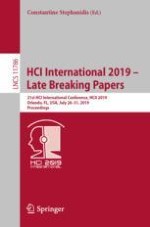This year the 21st International Conference on Human-Computer Interaction, HCII 2019, which was held in Orlando, Florida, USA, in July 2019, introduced the additional option of "late-breaking work", which applied both for papers and posters with the corresponding volumes of the proceedings.
The 47 late-breaking papers included in this volume were published after the conference has taken place. They were organized in the following topical sections: user experience design and evaluation; information, visualization, and decision making; virtual and augmented reality; learning and games; human and task models in HCI; and design and user experience case studies.
